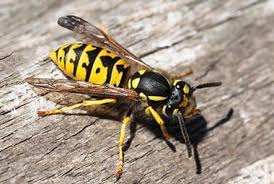Some Stinging Insects are Beneficial to our Environment, Others Can Be A Nuisance or Threat
While some stinging insects are beneficial to our environment, others prove to be a nuisance for your business’ employees and customers because of their continual search for food.
Stinging insects can also be a threat to the health of employees and customers. According to the National Pest Management Association, stinging insects send more than 500,000 people to the emergency room each year due to allergic reactions.
What stinging insects are encountered most frequently around commercial facilities? The list would include yellow jackets, paper wasps, honeybees, carpenter bees, and bald-faced hornets.
Stinging Insects to Know
Yellowjackets have nests numbering in the several thousands and continue their life cycle well into the late autumn. These are the wasps that harass customers, guests and employees at outdoor eateries, theme parks, congregate at bakeries or candy factories, seek out spilled sodas at sporting stadiums and fast-food restaurants. Their scavenger behavior puts them into interaction with humans which increases the potential for sting incidents
Paper wasps are often mistakenly called yellowjackets. These wasps are much longer in body and have a very thin “wasp-like” waist. They make nests under the eaves of structures, branches of trees and shrubs, porch ceilings, the tops of window and doorframes, soffits, eaves, attic rafters, deck floor joists and railings.
Bald faced hornets are an aggressive insect that although considered a hornet because of its large size and aerial nest, is more closely related to the yellowjacket group. They are often found in tree hollows and on dense shrubs and trees. They are protective of their nests and will aggressively attack and sting people and animals they deem a threat.
Where Stinging Insects Live
Stinging insects will establish nests in a variety of locations in and around commercial properties including:
- Trees and bushes
- Building corners, eaves and overhangs
- Inside attics and beams and supports in warehouses, barns or open-air facilities
- Gutters and poles
- Garbage and recycling dumpsters
- Inside exterior wall voids
- Loading docks
- In the hollows of playground equipment at schools, daycare facilities and parks
- Outdoor dining and food service areas including under furniture
How To Keep Stinging Insects Away from Your Commercial Property
The stinging insect experts at Sprague offer the following tips for commercial property owners and managers to keep these unwanted visitors in check:
- Reduce Spillage. Double-bag garbage and trash, and seal tightly. Carefully place the bags in the dumpster to prevent them from ripping and leaking. Do not drag trash bags to the dumpster.
- Clean Dumpsters. A clean, washed dumpster won’t be enough to keep wasps from foraging if there are spills in the surrounding areas, including the dumpster pad. It is equally important to keep the area between the back door and the dumpster clean.
- Empty the Trash. Trash containers should be emptied more frequently – daily at least – during warm weather. Never overfill dumpsters and empty outdoor containers near closing each day. Wasps often scout for food in the morning, so make sure there is nothing waiting for them.
- Clean Up Spills and Food Debris. Foraging wasps will quickly discover food, and more wasps will follow. A clean site prevents numerous other pests, such as flies, ants, birds and rodents. Insects attracted to food spills and debris can also attract more wasps because their larvae need protein to develop.
- Inspect Your Property. Keep an eye out for nests on the property. Early detection helps prevent nests from becoming large and aggressive.
For more information on how Sprague Pest Solutions can assist you establish an effective stinging insect prevention or management program, call 855.805.0755.

